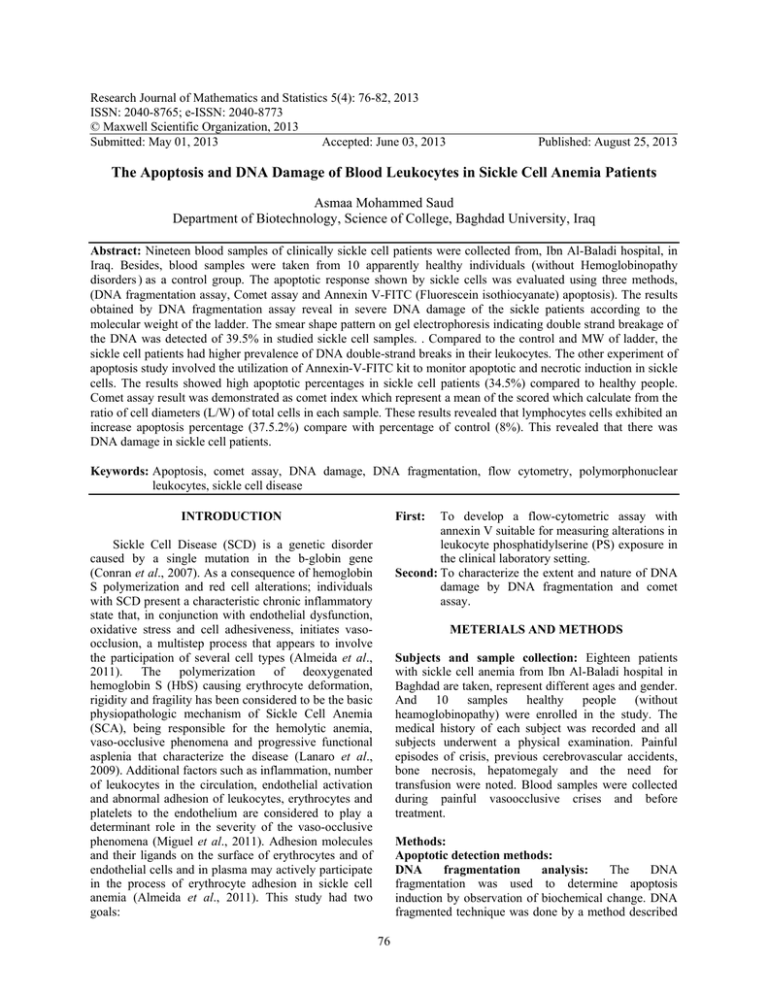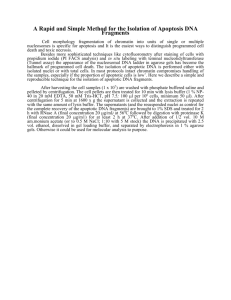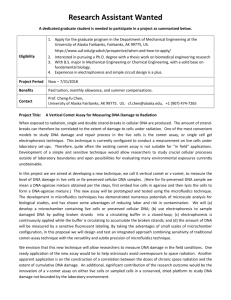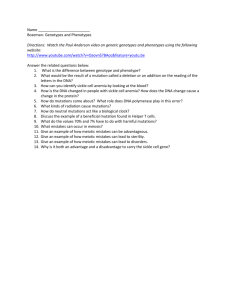Research Journal of Mathematics and Statistics 5(4): 76-82, 2013
advertisement

Research Journal of Mathematics and Statistics 5(4): 76-82, 2013 ISSN: 2040-8765; e-ISSN: 2040-8773 © Maxwell Scientific Organization, 2013 Submitted: May 01, 2013 Accepted: June 03, 2013 Published: August 25, 2013 The Apoptosis and DNA Damage of Blood Leukocytes in Sickle Cell Anemia Patients Asmaa Mohammed Saud Department of Biotechnology, Science of College, Baghdad University, Iraq Abstract: Nineteen blood samples of clinically sickle cell patients were collected from, Ibn Al-Baladi hospital, in Iraq. Besides, blood samples were taken from 10 apparently healthy individuals (without Hemoglobinopathy disorders ) as a control group. The apoptotic response shown by sickle cells was evaluated using three methods, (DNA fragmentation assay, Comet assay and Annexin V-FITC (Fluorescein isothiocyanate) apoptosis). The results obtained by DNA fragmentation assay reveal in severe DNA damage of the sickle patients according to the molecular weight of the ladder. The smear shape pattern on gel electrophoresis indicating double strand breakage of the DNA was detected of 39.5% in studied sickle cell samples. . Compared to the control and MW of ladder, the sickle cell patients had higher prevalence of DNA double-strand breaks in their leukocytes. The other experiment of apoptosis study involved the utilization of Annexin-V-FITC kit to monitor apoptotic and necrotic induction in sickle cells. The results showed high apoptotic percentages in sickle cell patients (34.5%) compared to healthy people. Comet assay result was demonstrated as comet index which represent a mean of the scored which calculate from the ratio of cell diameters (L/W) of total cells in each sample. These results revealed that lymphocytes cells exhibited an increase apoptosis percentage (37.5.2%) compare with percentage of control (8%). This revealed that there was DNA damage in sickle cell patients. 1T 1T 1T 1T 1T 1T 1T 1T 1T 8T 8T 8T 8T 8T 8T 8T 8T 8T 8T 8T 8T Keywords: Apoptosis, comet assay, DNA damage, DNA fragmentation, flow cytometry, polymorphonuclear leukocytes, sickle cell disease First: To develop a flow-cytometric assay with annexin V suitable for measuring alterations in leukocyte phosphatidylserine (PS) exposure in the clinical laboratory setting. Second: To characterize the extent and nature of DNA damage by DNA fragmentation and comet assay. INTRODUCTION Sickle Cell Disease (SCD) is a genetic disorder caused by a single mutation in the b-globin gene (Conran et al., 2007). As a consequence of hemoglobin S polymerization and red cell alterations; individuals with SCD present a characteristic chronic inflammatory state that, in conjunction with endothelial dysfunction, oxidative stress and cell adhesiveness, initiates vasoocclusion, a multistep process that appears to involve the participation of several cell types (Almeida et al., 2011). The polymerization of deoxygenated hemoglobin S (HbS) causing erythrocyte deformation, rigidity and fragility has been considered to be the basic physiopathologic mechanism of Sickle Cell Anemia (SCA), being responsible for the hemolytic anemia, vaso-occlusive phenomena and progressive functional asplenia that characterize the disease (Lanaro et al., 2009). Additional factors such as inflammation, number of leukocytes in the circulation, endothelial activation and abnormal adhesion of leukocytes, erythrocytes and platelets to the endothelium are considered to play a determinant role in the severity of the vaso-occlusive phenomena (Miguel et al., 2011). Adhesion molecules and their ligands on the surface of erythrocytes and of endothelial cells and in plasma may actively participate in the process of erythrocyte adhesion in sickle cell anemia (Almeida et al., 2011). This study had two goals: METERIALS AND METHODS Subjects and sample collection: Eighteen patients with sickle cell anemia from Ibn Al-Baladi hospital in Baghdad are taken, represent different ages and gender. And 10 samples healthy people (without heamoglobinopathy) were enrolled in the study. The medical history of each subject was recorded and all subjects underwent a physical examination. Painful episodes of crisis, previous cerebrovascular accidents, bone necrosis, hepatomegaly and the need for transfusion were noted. Blood samples were collected during painful vasoocclusive crises and before treatment. Methods: Apoptotic detection methods: DNA fragmentation analysis: The DNA fragmentation was used to determine apoptosis induction by observation of biochemical change. DNA fragmented technique was done by a method described 76 Asian J. Med. Sci., 5(4): 76-82, 2013 Preparation of slides for the SCGE/Comet assay: The microscopic slides had been covered with 1% Normal Melting Aagarose (NMA) at about 45°C in PBS before the experiment. This layer was used to promote the attachment of the second layer. For the second layer, cells mixed with 80 μL of 1% low melting agarose (LMA) (pH 7.4) then are rapidly pipette onto this slide, cells were spread using a cover slip and maintained on an ice-cold flat tray for 5 min to solidify. After removal of the cover slip, the slides are immersed in cold lysing solution (2.5 M NaCl, 100 mM EDTA, 10 mM Trise- base) with 1% Triton X-100 and 10% DMSO was added just before use for a minimum of 1 h at 4°C. previously by Rodriques et al. (2009). The DNA in the cell pellet was extracted using Promega kit and 2 µg of DNA are analyzed by electrophoresis on 1.8% w/v agarose gel containing 0.75% w/v ethidium bromide. Run gel electrophoresis at 250 voltages for 1 minute and 20 voltages for 4 h. After electrophoresis, DNA fragment was analyzed by using UV-laminated camera. Annexin V-FITC (fluorescein isothiocyanate) detection: Flow cytometry protocol: This evaluation is based on the early redistribution of phosphatidylserine from the inner to the outer layer of the cell membrane of apoptotic cells. During early apoptosis, a cell will stain with annexin V, which has a selective affinity for phosphatidylserine, but not with propidium iodide (PI). Propidium iodide stains the nucleus of cells with ruptured membranes. During late apoptosis, living cells will stain with annexin V and PI, but dead cells will stain only with PI (Dive et al.,1992; Sulowska et al., 2005a, b) Annexin V-fluorescein isothiocyanate (FITC) staining was performed with the annexin V-FITC apoptosis detection kit (Immunotech, Beckman Coulter, Marseille, France) according to the manufacturer’s instructions. Cells are harvested by centrifugation at 2,000 rpm for 5 min and cells are washed by gentle shaking or pipetting up and down with ice-cold 1X PBS (Ca++ and Mg++ free), resuspention pellet with 1X binding buffer and a just cell density to 2-5×105 cells/mL. Cells are stained with 5µL of Annexin V-FITC and Propidium Iodide (PI) and incubate for 15 min in dark at room temperature. After in an incubation period, cells are harvested by centrifugation at 2,000 rpm for 5 min, resuspend pellet in appropriate volume of binding buffer and the mixture was then analyzed by Flow Cytometry. Electrophoresis of slides: The slides are subjected to Electrophoresis in Tris-Borate- EDTE (TBE) buffer (pH = 8.3) at 24 volts (~0.74 V/cm) for 20 min. Slides are removed from the electrophoresis chamber and fixed for 5 minutes with 70% ethanol; slides were dried at room temperature in the dark. Slides are stained with diluted Ethidium Bromide for 5 minutes at 4°C and slides gently tap to remove excess Ethidium Bromide and dry completely at room temperature in dark. Cells are observed at (40×magnify) with inverted fluorescence microscope. Fifty randomly selected cells are count per sample to quantify the apoptotic cell percentage. Scored was calculated from the ratio of (L/W) comet to determine the Comet Index (CI). Scored range from 1.2 to 2 considered low DNA Damage (LD), from 2.1 to 3 medium DNA Damage (MD) and up to 3 high DNA damage (HD) (Collins et al., 2003; Saud, 2012). RESULTS AND DISCUSSION Apoptotic effect of sickle cell patients: DNA fragmentation analyses: DNA Fragmentation analyses were one of the hallmarks of late stages of apoptosis process. The smear shape pattern on gel electrophoresis indicating double strand breakage of the DNA was detected in 39.5% scoring in severe damage of the sickle cell patients according to the Molecular Weight (MW) of the ladder. Compared to the control and MW of ladder, the sickle cell patients had higher prevalence of DNA double-strand breaks in their leukocytes. The DNA ladder of sickle cell patients was more clearly observed in Fig. 1. Sickle cell patients were particularly at risk of free radical induced damage caused by increased generation of (ROS) (Meerang et al., 2008; Bertram and Hass, 2008). DNA damage in peripheral leukocytes of our sickle cell patients was investigated depending on the fact that circulating leukocytes were surrogate cells which continuously maintain a surveillance of the body for signs of toxic and antitoxic exposures (Merchant et al., 2010). Results of this study revealed that the smear shape pattern on gel electrophoresis indicating double stranded breakage of the DNA conferring Neutral Comet Assay (Single Cell Gel Electrophoresis) (SCGE): Neutral Comet assay was used to investigate the possible DNA damage in peripheral blood lymphocytes from patients with βthalassemia in comparison to healthy controls. Olive and Banáth (2006) and Collins et al. (2008) were adopted for preparation of the neutral Comet assay solutions. Isolated lymphocytes: Lymphocytes from a 2 ml anticoagulant whole blood are isolated by lymphoprep density gradient centrifugation and washed in Phosphate Buffer Saline (PBS). Cell concentrations are adjusted to approximately 2×105 cell/mL in the buffer. Aliquots of 5-10 μL of the cells are suspended in 75 μL of low melting point agarose (LMA) for embedding on slides. Cells are checked for viability by trypan blue exclusion. 77 Asian J. Med. Sci., 5(4): 76-82, 2013 (secondary necrosis) (PI-positive/annexin V-positive) region C: vital cells (PI-negative/ annexin V-negative); region D: apoptotic cells (PI-negative/annexin Vpositive). The investigated normal and apoptotic cells were divided into two groups: Group (a): For healthy control Group (b): For patients with sickle cell diseases The mean Annexin-V staining value that indicated early apoptotic leukocyte was higher in patients with sickle cell diseases than in healthy controls (34.5% vs. 0.1%, respectively) Table 1. Leukocyte with the typical features of apoptosis (early apoptotic, late apoptotic and dead leukocyte were shown in (Fig. 2). Phospholipid asymmetry in the red blood cell lipid bilayer was well maintained during the life of the cell, with Phosphatidylserine (PS) virtually exclusively located in the inner monolayer. Loss of phospholipid asymmetry and consequently exposure of PS, was thought to play an important role in red cell pathology and which was characteristic of apoptosis (Sylvia et al., 2008; Srinoun et al., 2009a). The anemia in the human sickle cell diseases was caused by a combination of ineffective erythropoiesis (intramedullary hemolysis) and a decreased survival of adult red blood cells in the peripheral blood (Libani et al., 2008). This premature destruction of the sickle red blood cell could in part be due to a loss of phospholipid asymmetry, because cells that exposed PS were recognized and removed by macrophages (Ponnikorn et al., 2011). The use of labeled annexin V allowed us to determine loss of phospholipid asymmetry in individual cells. The number of such cells can vary dramatically from patient to patient (Meerang et al., 2009). These membrane sites in which iron carrying globin chains accumulate and cause oxidative damage, could be important in the loss of membrane lipid organization (Srinoun et al., 2009b). Giovanna et al. (2008) and Ferrer et al. (2010) indicating that activated lymphocytes in thalassemic and sickle cell patients were more susceptible to oxidative stressinduced death than are controls. Studies of haemolysis had indicated that oxidant injury to circulating erythrocytes was of critical importance, with evidence of oxidative stress in red blood cell proteins (Fibach and Rachmilewitz, 2008). Increased exposure of Phosphatidylserine (PS) in cells has been postulated to contribute to the pathophysiology of sickle cell disease because of its possible effects on blood coagulation, cell adhesion and Fig. 1: Electrophoresis pattern of separated DNA from sickle cell patients and some control. Marker: molecular weight of marker (100 bp); Lanes 2: show shaped DNA damage of severe degree for sickle cell patients (200 bp). Lane 1: shows intact DNA from healthy people (control).On 1.8% agarose gel at 24 voltages for 4 h fragmentation of extremely variable sizes (confirmed by the marker 100bp) was the main finding among sickle cell patients. Compared to the control group, Lanes 2 shows shaped DNA damage of severe degree for sickle cell patients (200bp). Lymphocytes from sickle cell patients were reported to have higher levels of both background and induced DNA damage particularly DNA strand breaks as measured in a comet assay by Anderson et al. (2000). Offer et al. (2005) reported that relative to healthy control subjects, patients with sickle cell exhibited elevated levels of DNA damage as reflected by an increase in micronuclei containing red blood cells. Moreover, iron plays an important role in oxidative tissue damage. DNA has also been reported to be a target of iron-induced damage. Levels of some antioxidants were decreased during iron overload (Toyokuni, 2009). In accordance to these results, Park et al. (2007) had concluded that iron markedly induced DNA damage in humans and rat leukocytes, denoting that these white blood cells were sufficiently sensitive to assess exposure to iron and the measurement of DNA damage in human leucocytes could be used as a sensitive biomarker to study iron overload in vivo in humans. Annexin V-FITC apoptosis detection: Differentiating between sickle cells of either apoptosis or necrosis was carried out using Annexin V-FITC kit. The different labeling patterns in this assay identify the different cell populations, e.g., region A: necrotic cells (PIpositive/annexin V-negative); region B: late apoptosis Table 1: Score range and apoptosis % in lymphocyte isolated from sickle cell patients by flow cytometry machine Scoring Necrotic cells-A (%) Late apoptosis cells-B (%) Viable cell-C (%) Control (a) 0 0.1 99.8 Patients (b ) 1.5 5 59 78 Apoptotic cells-D (%) 0.1 34.5 Asian J. Med. Sci., 5(4): 76-82, 2013 Fig. 2: Annexin V expression for sickle cell patients induced apoptosis analysis, a: control; c: range percentage of apoptotic cells for sickle cell patients cell clearance. We developed a flow-cytometric assay to measure exposure of PS on the outer face of the blood cell membrane based on addition of fluoresceinannexin V to whole-blood specimens (Wood et al., 1996). Adhesion molecules on the surface of erythrocytes, leukocytes and platelets are involved in vascular occlusion in sickle cell anemia. Hydroxyurea treatment of sickle cell anemia patients leads to clinical improvement and reduces the incidence of vasoocclusive episodes. It has been previously demonstrated that hydroxyurea treatment also reduces the expression of adhesion molecules on the surface of erythrocytes. Phosphatidylserine (PS) exposure on the surface of erythrocytes has been considered to be the main determinant of altered erythrocyte adhesion in sickle cell anemia (Covas et al., 2004). based on scoring the comets into categories. Then scored was calculated from the ratio of cell diameters (L/W) comet to determined the Comet Index (CI), with cell exhibiting no migration having a ratio of ≈ 1 Fig. (3A) (Cok et al., 2004; Saud, 2012). The scoring was conducted in three levels of DNA damage were assigned ranging from 1.2 to 2 considered low DNA damage (LD), from 2.1 to 3 medium DNA damage (MD) and up to 3 high DNA damage (HD) (Fig. 3B to D). It was recommended to score fifty or more cells per slide and at least 2 duplicate slides for each sample along with positive and negative controls (Jeong, 2007). The final score results (no units) which is consider as a comet index for each slide. The apoptotic cells could be clearly distinguished from unapoptotic cells or necrotic cells by the pattern of comet image. Neutral comet assay successfully differentiated the two types of cell death. Apoptotic nuclei showed longer comet tails with high score, whereas necrotic nuclei yielded almost no tails, which implied that this assay could be used to differentiate apoptosis from necrosis (Offer et al., 2005). The comet image of apoptotic cells has the tail separated from the comet head (Olive and Banáth, 2006). The apoptotic cells could be classified into two types based on the DNA migration patterns: completely Neutral comet assay (single cell gell electrophoresis): The neutral comet assay or single cell electrophoresis was a sensitive method of detection double strand break of DNA caused by apoptosis (Khoa et al., 2002). In this study follow some investigators to analyze the results by a manual method using ruler in photo of cell on computer monitor (Tice et al., 2000; Collins et al., 2008) to quantify DNA damage caused by apoptosis 79 Asian J. Med. Sci., 5(4): 76-82, 2013 Table 2: Score range and apoptosis % of lymphocyte in sickle cell patients by comet assay techniqe No damage Low Damage Medium Damage Score rang % (ND) % (LD) % (MD) % Control 92 8 0 Sickle cell patients 62.5 12.5 11 (HD) High damage % 0 14 Apoptosis % 8 37.5 detection apoptosis because it was easy, sensitive and quantitative. In these studies, observation of early onset of apoptosis and of various types of DNA strand cleavage was demonstrated under specific condition. REFERENCES 3T Almeida, C.B., M.E. Favero, F.G. Pereira-Cunha, I. Lorand-Metze, S.T. Saad et al., 2011. Alterations in cell maturity and serum survival factors may modulate neutrophil numbers in sickle cell disease. Exp. Biol. Med., 236: 1239-1246. Anderson, D., Y.A. Jones, V.C. Bauza, C.W. Anusorn, C. Cole and J. Webb, 2000. Effect of iron salts, haemosiderins and chelating agents on the lymphocytes of a thalassaemia patient without chelation therapy as measured in the comet assay. Teratogen. Carcin. Mut., 20(5): 251-264. Barberino, W.M., E. Belini-Junior and C.R. BoniniDomingos, 2012. Comet assay as a technique to evaluate DNA damage in sickle cell anemia. Patients Rev. Bras. Hematol. Hemoter., 34(1): 67. Bertram, C. and R. Hass, 2008. Cellular responses to reactive oxygen species-induced DNA damage and aging. Biol. Chem., 389(3): 211-220. Cok, I., S. Semra, K. Ela and O. Eren, 2004. Assessment of DNA damage in glue sniffers by use of the alkaline comet assay. Mutat. Res., 55(2): 131-136. Collins, A.R., A.A. Oscoz, G. Brunborg, I. Gaiva, L. Giovannelli, M. Kruszewski, C.C. Smith and R. Stetina, 2008. The comet assay: Topical issues. Mutagenesis, 23(3): 143-151. Collins, A.R., V. Harrington, J. Drew and R. Melvin, 2003. Nutritional modulation of DNA repairs in a human intervention study. Carcinogenesis, 24: 511-515. Conran, N., S.T. Saad, F.F. Costa and T. Ikuta, 2007. Leukocyte numbers correlate with plasma levels of granulocyte-macrophage colony-stimulating factor in sickle cell disease. Ann. Hematol., 86: 255-261. Covas, D.T., L.D. Lucena, A.P. Vianna and M.A. Zago, 2004. Effects of hydroxyurea on the membrane of erythrocytes and platelets in sickle cell anemia. Haematologica, 89: 273-280. Dive, C., C.D. Gregory, D.J. Phipps, D.L. Evans, A.E. Milner and A.H. Wyllie, 1992. Analysis and discrimination of necrosis and apoptosis (programmed cell death) by multiparameter flow cytometry. Biochim. Biophys. Acta, 1133: 275-285. Fig. 3: Three examples of scoring categories for comet assay, (A) Electrophoresis under neutral conditions in low melting point agarose gel of the cells of a subject without any hemoglobinopathy and thus without DNA damage, (B) Electrophoresis under neutral conditions in low melting point agarose gel of the cells of a sickle cell disease patient with damage classified as Comet class LD, MD, HD apoptotic cells and cells undergoing apoptosis. The former with apoptotic DNA fragmentation were clearly identified by the complete separation of the tail from the small comet head. Apoptosis was assessed after electrophoresis with the cells being classified according to their comet index which represent the ratio of L/W of the cells after electrophoresis, as described in experimental procedures. When comparing peracentage the values of DNA strand break of our sickle cell patients and normal it was found that 8% in normal and 37.5% in sickle cell patients. This revealed that there was DNA damage in sickle cell patients (Table 2 and Fig. 3). Barberino et al. (2012) conferm the Comet Assay is a technique which can detect single-strand breaks as initial DNA damage. And Cells submitted to electrophoresis under alkaline conditions in low melting point agarose gel show DNA damage in a comet-like form when viewed at fluorescence microscopy. The lesion from each cell is quantified according to the comet tail length as class 0, 1, 2 or 3. In sickle cell disease, due to constant oxidative stress and membrane lesions, this assay can be useful to detect DNA lesion intensity and medication response. Hydroxyl radicals (OH●) were the most reactive oxygen free radical species capable of direct oxidative damage to macromolecules including DNA, protein and lipid membranes (Walter et al., 2006). Complication of oxidative stress in sickle cell patients could be due to consumption of enzymes and non enzymes antioxidants and increase of oxidative stress as free radical effect of DNA (Waris and Ahsan, 2006). Yasuhara et al. (2003) used modified comet assay (neutral comet assay) for P 3T P 80 Asian J. Med. Sci., 5(4): 76-82, 2013 Ferrer, M.D., A. Sureda, P. Tauler, C. Palacı´n, A. Tur and P. Antoni, 2010. Impaired lymphocyte mitochondrial antioxidant defences in variegate porphyria are accompanied by more inducible reactive oxygen species production and DNA damage. Brit. J. Haematol., 149(5): 759-767. Fibach, E. and E. Rachmilewitz, 2008. The role of oxidative stress in hemolytic anemia. Curr. Mol. Med., 8(7): 609-619. Giovanna, R., R.F. Degasperi and A.E. VercesiI, 2008. High susceptibility of activated lymphocytes to oxidative stress-induced cell death. An. Acad. Bras. Cienc., 80(1): 137-148. Jeong, Y.N., 2007. Arsenic toxicity in PLHC-1 line and the distribution of arsenic in central Appalachia. M.Sc. Thesis, Marshall University, USA. Khoa, T.V., L.V. Trung, K.N. Hai and N.T. Chien, 2002. Detection of apoptotic frequency in Chinese Hamster Ovary (CHO-K1) cells after gammairradiation using both netural comet assay and Terminal Desoxynucleotidyl Transferase (TdT) assay. Environ. Health. Prev. Med., 7: 217-219. Lanaro, C., C.F. Franco-Penteado, D.M. Albuqueque, S.T. Saad, N. Conran and F.F. Costa, 2009. Altered levels of cytokines and inflammatory mediators in plasma and leukocytes of sickle cell anemia patients and effects of hydroxyurea therapy. J. Leukocyte. Biol., 85: 235-242. Libani, I.V., E.C. Guy, L. Melchiori, R. Schiro, P. Ramos and L. Breda, 2008. Decreased differentiation of erythroid cells exacerbates ineffective. Blood, 112(3): 875-885. Meerang, M., J. Nair, P. Sirankapracha, C. Thephinlap, S. Srichairatanakool and S. Fucharoen, 2008. Increased urinary 1, N6-ethenodeoxyadenosine and 3, N4- ethenodeoxycytidine excretion in thalassemia patients: Markers for lipid peroxidation- induced DNA damage. Free Radic. Biol. Med., 44(10): 1863-1868. Meerang, M., J. Nair, P. Sirankapracha, C. Thephinlap, S. Srichairatanakool, K. Arab, R. Kalpravidh, J. Vadolas, S. Fucharoen and H. Bartsch, 2009. Accumulation of lipid peroxidation-derived DNA lesions in iron overloaded thalassemic mouse livers: Comparison with levels in the lymphocytes of thalassemia patients. Int. J. Cancer., 125(4): 759-766. Merchant, R., A. Jain, A. Udani, V. Puri and M. Kotian, 2010. L-carnitine in beta thalassemia. Indian Ped., 47(2): 165-167. Miguel, L.I., C.B. Almeida, F. Traina, A.A. Canalli, V.M. Dominical, S.T.O. Saad, F.F. Costa and N. Conran, 2011. Inhibition of phosphodiesterase 9A (PDE9A) reduces cytokine-stimulated in vitro adhesion of neutrophils from sickle cell anemia individuals. Inflamm. Res., 60: 633-642. Offer, T., A. Bhagat, A. Lal, W. Atamna, S.T. Singer and E.P. Vichinsky, 2005. Measuring chromosome breaks in patients with thalassemia. Ann. N.Y. Acad. Sci., 1054: 439-44. Olive, P.L. and J.P. Banáth, 2006. The comet assay: A method to measure DNA damage in individual cells. Nat. Protoc., 1: 23-29. Park, E., M. Glei, Y. Knobel and Z.B.L. Pool, 2007. Blood mononucleocytes are sensitive to the DNA damaging effects of iron overload--in vitro and ex vivo results with human and rat cells. Mutat. Res., 619(1-2): 59-67. Ponnikorn, S., T. Panichakul, K. Sresanga and C. Wongborisuth, 2011. Phosphoproteomic analysis of apoptotic hematopoietic stem cells from hemoglobin E/b-thalassemia. J. Transl. Med., 9: 96. Rodriques, L.V., A.C. Vasconcelos, P.A. Campos and J.M. Bbrant, 2009. Apoptosis in pulp elimination during physiological root resorption in human primary teeth. Braz. Dent. J., 20(3): 179-185. Saud, A.M., 2012. Molecular and biochemical study on β-thalassemia patients in Iraq. Ph.D. Thesis, Institute of Biotechnology for College of Science, University of Baghdad, Iraq. Srinoun, K., S. Svasti, W. Chumworathayee, J. Vadolas and I. Phantip, 2009a. Imbalanced globin chain synthesis determines erythroid cell pathology in thalassemic mice. Haematologica, 94(9): 1211-1219. Srinoun, K., S. Svasti, W. Chumworathayee, J. Vadolas and I. Phantip, 2009b. Imbalanced globin chain synthesis determines erythroid cell pathology in thalassemic mice. Haematologica, 94(9): 1211-1219. Sulowska, Z., E. Majewska, M. Klink, M. Banasik and H. Tchorzewski, 2005a. Flow cytometric evaluation of human neutrophil apoptosis during nitric oxide generation in vitro: The role of exogenous antioxidants. Mediat. Inflamm., 2: 81-87. Sulowska, Z., E. Majewska, M. Klink, M. Banasik and H. Tchorzewski, 2005b. Flow cytometric evaluation of human neutrophil apoptosis during nitric oxide generation in vitro: The role of exogenous antioxidants. Mediat. Inflamm., 2: 81-87. Sylvia, S.T., V. Elliott, L. Sandra, O. Nancy, S. Nancy and K.A. Frans, 2008. Hydroxycarbamide-induced changes in E/beta thalassemia. Red Blood Cells Am. J. Hematol., 83(11): 842-845. Tice, R.R., E. Agurell, D. Anderson, B. Burlinson, A. Hartmann, H. Kobayashi, Y. Miyamae, E. Rojas, J.C. Ryu and Y.F. Sasaki, 2000. Single cell gel/comet assay: Guidelines for in vitro and in vivo genetic toxicology testing. Environ. Mol. Mutagen., 35(3): 206-221. 81 Asian J. Med. Sci., 5(4): 76-82, 2013 Toyokuni, S., 2009. Role of iron in carcinogenesis: Cancer as a ferrotoxic disease. Cancer Sci., 100(1): 9-16. Walter, P.B., E. Fung, D.W. Killilea, Q. Jiang, M. Hudes and J. Madden, 2006. Oxidative stress and inflammation in iron-overloaded patients with bthalassemia or sickle cell disease. Br. J. Haematol., 135: 254-263. Waris, G. and H. Ahsan, 2006. Reactive oxygen species: Role in the development of cancer and various chronic conditions. J. Carcinog., 5: 14. Wood, B., L. Gibson and J.F. Tait, 1996. Disease: flowcytometric measurement and clinical associations Increased erythrocyte phosphatidylserine exposure in sickle cellbloodjournal. Hematologyl. Org., 88: 1873-1880. Yasuhara, S., Y. Zhu, T. Matsui, N. Tipirneni, Y. Yasuhara, M. Kaneki, A. Rosenzweig and J.A.J. Martyn, 2003. Comparison of comet assay, electron microscopy and flow cytometry for detection of apoptosis. J. Histochem. Cytochem., 51(7): 873-885. 82



